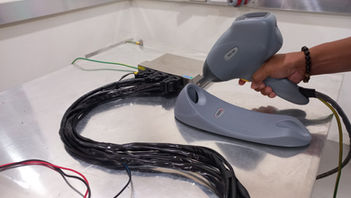






Niche Centers in the Regions for R&D
E-MOBILITY NICER
Electric Mobility Research and Development Center for the PH Electric Vehicle Industry




ABOUT THE PROGRAM
The E-Mobility NICER (Niche Centers in the Regions for R&D) is a collaboration between the Department of Science and Technology (DOST), the University of the Philippines Diliman (UPD) and Cagayan State University (CSU) Carig Campus. The program established the E-Mobility R&D Center in Tuguegarao City, Cagayan to be one of the R&D, testing, and production hubs of electric vehicles in the country. The NICER Program currently designs and manufactures E-Trikes for the domestic market engaging Filipino engineers, skilled local fabricators and utilizing locally-sourced raw materials.
Project 1 under CSU deals with the fabrication of the chassis, body and suspension system of the vehicles. Project 2 under UPD on the other hand deals with the design and production of the whole electrical and electronics system of the vehicles. Project 3 that is also under CSU produced converted electric tricycles that utilized the conventional body of the Philippine tricycle.
Objectives of Project 2

Determine the optimal design and implementation of the electrical and electronic system with respect to the mechanical design of the
E-Trike

Fabricate, test and characterize the vehicle’s electrical and electronic system both in laboratory and
on-road in accordance to the Philippine National Standards

Facilitate knowledge exchange between UP Diliman and CSU for their E-Mobility Center in terms of testing and development of the vehicle components



E-trike Specifications
MODEL 1
- 6 Passengers + Driver
- Rear entry configuration
- Sheet metal body
- 47 kph maximum speed
- 5kW motor | 7.2 kWh battery
Charging:
3.5 hours on regular charging
30-45 minutes on fast charging
MODEL 2
- 7 Passengers + Driver
- Side entry configuration
- Fiberglass body
- 47 kph maximum speed
- 5kW motor | 7.2 kWh battery
Charging:
3.5 hours on regular charging
30-45 minutes on fast charging
UP MODEL
- 4 Passengers + Driver
- Rear entry configuration
- Modified body in partnership with EVWealth (fiberglass & sheet metal)
- 4kW motor | 4.3 kWh battery
Charging:
2 hours on regular charging
30 minutes on fast charging
1.
Vehicle Control Unit
2.
Battery System and BMS
-
Lithium-ion (LiFeYPO4)
-
72V 100Ah | 60Ah
3.
Electric Motor
-
AC Induction Motor
-
3-Phase 5kW 80Nm
-
3000 RPM rated, 6000 RPM max
4.
Gearbox/Drivetrain
-
Single reduction 12.76:1
-
Rear axle differential assembly
-
Up to 50kph max speed
5.
Motor Controller
6.
-
Input: 48-72V DC nominal
-
5kW rated output, 0-300Hz 3P
On-board Charger
7.
-
2kW charger
Charging Ports
-
Regular charging - Mode 3
-
Fast charging - CharM, Mode 4

2
6
3
7
4
5
1


















